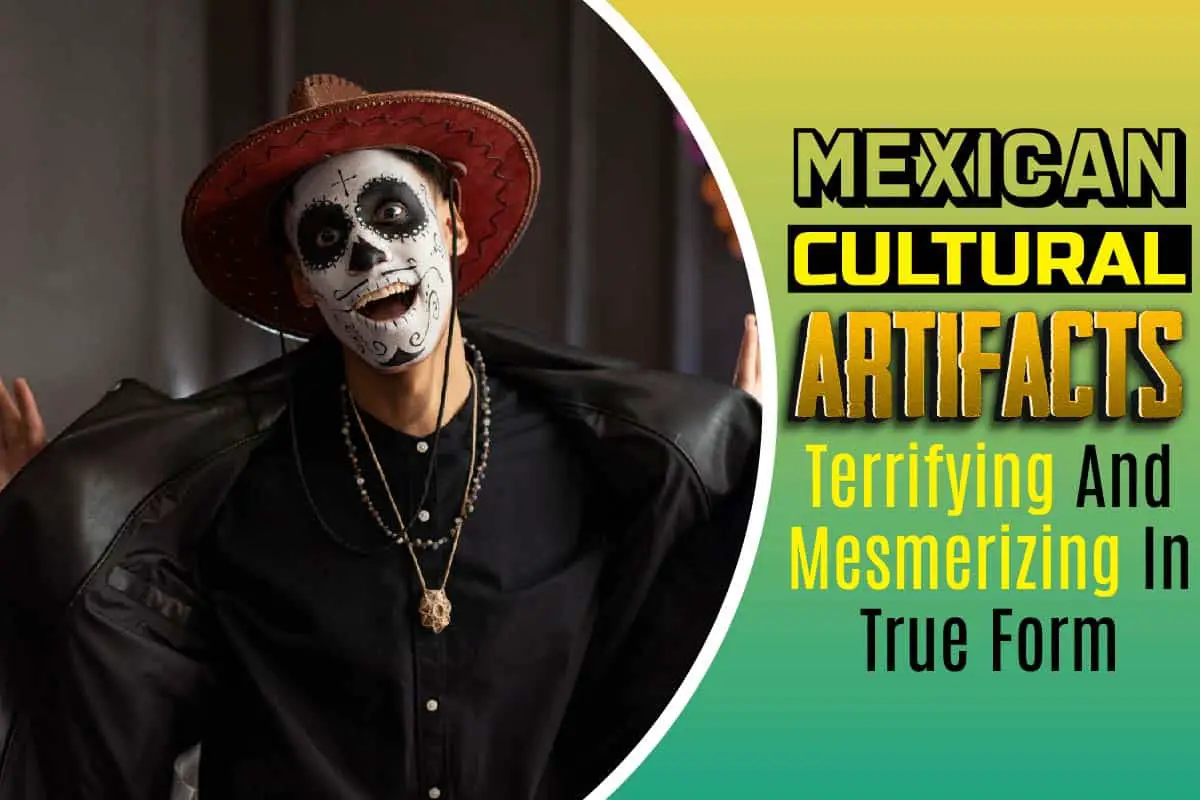The ideas that govern us come from the culture we live in. Whether we like it or not, integration is inescapable. Every place has its own essence. As days and years pass by, this essence expands to take in new beliefs, cultures, and traditions.
If you’re interested in Mexican culture, start by looking into the times of the Nahua, the Aztec, the Mexica through the telescope of Mexican cultural artifacts. Not even your favorite taco bar will be able to give you a better understanding of the peculiar charm that binds the natives of Mexico.
So, without further ado, let’s dive into the fascinating world of cultural assets and all that they represent.
Top 8 Mexican Cultural Artifacts
Here are all the Mexican cultural artifacts that you should know about.
1. Alebrijes
Alebrijes are animal sculptures that are traditionally made of paper or wood, and they are generally used as decorations in special events.
They are very colorful and quite absurd because they don’t embody one particular animal, rather a curious amalgamation that makes your imagination run wild.
The head of a tiger, the body of an elephant, the front legs of birds, and the rear legs of a goat – this is what the typical Alebrijes will look like. There are those with more defined meanings as well.
Walt Disney’s Coco (2017) represented Alebrijes as “spirit guides” that lead the soul between the worlds of the dead and the living. Not too far off if you consider their Aztec origin.
Originally, Alebrijes were created by Aztec people about 2500 years ago. But they are more commonly attributed to Pedro Linares López – the Spanish sculptor whose creations brought Alebrijes to much limelight.
If you find yourself in Oaxaca, Mexico, on Dia de Los Muertos, you will surely see Alebrijes hanging all around the city.
2. Coatlicue – The Earth Goddess
This piece was so ugly that the Spanish authorities put it back underground after discovering it. But of course, it was too controversial to be kept under the covers.
So, it was dug up again, and since then, it has been gathering an array of contrasting opinions for itself. Not another piece of cultural art can be found in Mexico with a greater pool of critics.
This sculpture represents the Mexican Goddess of Earth. She is, well, quite terrifying.
From her jaws extrude two fanged serpents, and numerous snakes wrap around her body. She wears a necklace made out of human hearts, severed hands, and skulls. Coatlicue is the brightstar of childbirth and the black death of improper behavior and promiscuity.
Standing 8.3 feet tall, this Earth Goddess can simultaneously intimidate and invigorate the boldest of human beings. It resides in Museo Nacional de Antropología and draws in art enthusiasts and patrons from all around the world every month.
3. Molcajete and Tejolete
This artifact is not even close to being as controversial as the goddess, but it is indeed immensely useful. Molcajetes and Tejoletes are stone tools from ancient times.
They look like a mortar and pestle, except that they are superbly prehistoric in appearance. These tools look so old and jagged because Aztecs and Mayans made these out of basalt that came straight out of the volcanoes.
But these stone tools are still used by Mexicans today to grind spices. If you love Mexican food, you will notice that these artifacts are used for the preparation of food everywhere in Mexico.
4. Mosaic Mask of Tezcatlipoca/Smoking Mirror
To begin, we must say that this mask looks incredibly cool. The eyes on this mask are made with orbs of iron pyrite that have been polished to a smooth texture. A beautiful white strombus shell encloses the eyes and adds dimension to the mask.
The rest of it is created with deerskin and maguey fiber, but the most striking feature of the mask is the two blue mosaic straps that go across its face. Reflective lignite pieces bend blue light in curious angles and create an allure around your senses if you look at it for too long.
This mask belongs to Tezcatlipoca, who was one of the four major Mexican deities during the Aztec empire. In Nahuatl, he is known as the God of the Boar constellation and the creator of the night sky. It is said that he, along with his brother, created both the sky and the earth.
5. Penacho of Moctezuma II
Iridescently glowing bright green and blue, this headdress is something that produces a natural holographic effect due to the mix of the quetzal and other feathers that it has been bedazzled with.
If a majestic ruler comes to mind when you look at this crown, then you’re not far from the truth. This headdress belongs to Moctezuma II – an Aztec emperor active during the Spanish-Aztec War. Quite a bit of controversy follows this penacho.
Despite being a semblance of peak Aztec beliefs and style, this masterpiece of Mesoamerican art was found in Austria.
The most logical explanation for this is that the headdress was passed on to a Spanish conquistador called Hernán Cortés by the emperor himself. Travels of the conquistador took him and this headdress to Austria, where it was discovered and stored many years later.
Although there is no solid evidence to suggest this, the simple fact that it was found in Austria was enough to have the Austrian government make a claim on it. Mexicans obviously want it back, and a dispute arose. Later, the Austrian government settled on returning it.
However, the artifact has yet to be returned to Mexico. Careful examinations of the object have revealed that it’s too fragile for such long-distance air travel. Thus, Austria gets to keep it until a safe delivery can be arranged.
On the other hand, the Mexican government has, after much reluctance, agreed to keep a replica of the original in their museum.
6. Ceramic Statues of Mictlantecuhtli
In 1994, two ceramic figures were found under a street in Central Mexico. The figures were of Mictlantecuhtli – the Aztec God of the Dead.
Looking at the statues, you would know that the Aztecs did not have much love for Mictlantecuhtli. Well, that is not unreasonable, for he is, after all, the God of Death.
So, the spectacle of the statue has been formed with much grotesqueness. Half of the god’s body is stripped off of its flesh. His ribs are exposed, and his liver hangs freely from below the ribcage. Quite a pathetic show, but the statue is not created with undue hatred. Rather, it provides much context that is necessary.
You see, Mictlantecuhtli lived in the lowest and the dampest part of the universe – a cold and damp place called Mictlan. Mictlan is also the word for liver. In ancient times, the liver was considered to be a source of diseases.
Now piece it all together – living in Mictlan, with a hanging liver, Mictlantecuhtli takes lives into the damp place of the universe and gives back death to Earth.
7. Obsidian Texcoco Jar
This black stone effigy portrays the figure of a monkey with its tail raised up over its head as it holds onto the rim of the jar. Its legs are on its sides as it appears to be forever astonished at its viewer.
Here, this jar was used as a funerary benefaction. The monkey represents the poetry of a failed creation, alluding to the similarity between humans and our primate equivalents who were left just too close to the perfect existence that humans have been given.
This artifact is one of the most famous installations in Museo Nacional de Antropología. It is made with obsidian – a curious rock with a so deeply black color that it can reflect light back with minimum refraction.
Obsidian is incredibly unique, to begin with, and this installation of the Texcoco Jar honors the incredible skill of the Aztec who have made it shine like a black mirror. These were all but volcanic rocks before they were refined with such sophisticated skills.
8. Circle of Friends
Passing joints? No papa.
This Mexican artifact has made quite some rounds on the internet, and it’s not hard to guess why. But keeping innuendos aside, we must say that this artifact is quite an exciting one. There are many versions of it with a differing number of friends in the circle.
One version shows seven friends holding each other arm to arm, while another has eight. Another version has nine friends! One thing in common among all these sculptures is music and dance.
Each time, the circle revolves around a source of music or dance in its center. There’re two versions with a drummer in the middle and one with a dancing couple in the middle.
Some even come with an empty circle in the center – these can be used as incense burners to add representation of a life source exuding from the center.
Conclusion
Culture enthralls us all. There’s much in the world that is amazing, wonderful, and terrifying at the same time.
The Aztecs elevated the culture in the Mesoamerican regions by the thorough refinement of their art, skills, and lifestyles. Their influence is strictly preserved and protected to this day due to great diligence from the Mexican government to protect all of the precious Mexican cultural artifacts.
There’s much more to the Mexican culture that we can fit here. If you liked this article, let us know, and we’ll do more.
You May Like These Articles As Well:
Similarities And Differences Between Chinese Vs Japanese Culture
 Being Human
Being Human




